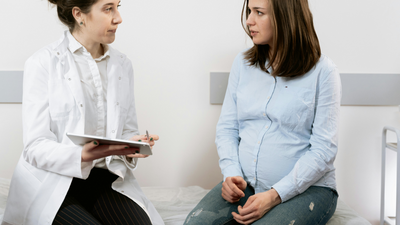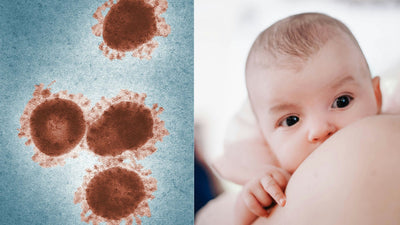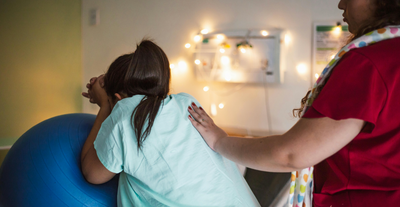Mastitis, Breastfeeding, and Antibiotics: 5 Things You Need to Know
Mastitis, Breastfeeding, and Antibiotics: 5 Things You Need to Know
By Jordan Berns
Over the course of one year, the average breastfeeding woman spends about 1,800 hours nursing her baby. That’s almost the equivalent of working a full-time job for 40 hours per week! Just like we often put out little fires at work, the same can be said for breastfeeding. When breastfeeding around the typical 8 to 12 times a day, a little pinch of pain can soon transform into a huge problem. One of these problems is called mastitis. Up to 40% of women contract this painful and potentially dangerous condition, with 8.5% of women experiencing repeat cases.
Developing mastitis almost always means putting a pause on breastfeeding. Treating mastitis early can be the key to maintaining breast milk production and your lactating health. Lactation Lab offers at-home mastitis testing strips that can help diagnose cases immediately so you can get the care you need as fast as possible!
Mastitis can be complicated to treat. One of the reasons that mastitis sometimes spells the end of the breastfeeding journey is due to the way this condition is treated. The classic treatment of mastitis is antibiotics. No problem, right? Not quite! While on antibiotics, most doctors recommend stopping breastfeeding because antibiotics absorb into your breast milk and can cause lifelong issues for your baby.
1) What is mastitis?
There are two types of mastitis: infective and non-infectious. Infective mastitis is an infection in the breast often caused by a plugged duct or milk statis (milk not being able to properly move through the breast). Other times, mastitis is the result of bacteria from babies’ mouths breaking though the mother’s skin through nipple injuries. The bacteria most responsible for this malady is Staphylococcus aureus (S. aureus) and coagulase-negative Staphylococci, the former being more likely. It’s possible, but rare, that strains of Escherichia coli are the culprit. Mastitis can also be a result from a poor latch that isn’t emptying out ducts correctly or a weakened immune system, usually from exhaustion or stress. Infections spread easily in the breast due to the high lactose levels in breast milk, so it’s important to seek help if the symptoms don’t resolve in a day or two.
Non-infectious mastitis, which is much less common, usually occurs from duct ectasia, which is when the walls of a milk duct thicken as the duct widens. One of the causes of non-infectious mastitis is a foreign object, like a breast implant or nipple piercing, that causes irritation then infection. Non-infective mastitis can also be inflammation from milk statis, however this can soon progress into infective mastitis. Symptoms of infective and non-infectious mastitis are virtually identical.
2) How is mastitis treated?
If you suspect you have mastitis, contact your doctor as soon as possible, especially if you spike a fever over 101°F/38.3°C. Your doctor will perform a physical exam and ask you about some of your symptoms, as well as running some simple tests. At-home mastitis strips can give you a clear indication if you are suffering from mastitis, helping you know what your next steps should be to protect your baby and your own health.
Mastitis is usually treated with a ten-day course of antibiotics along with hand-expressing breast milk (to prevent milk from becoming stagnant). According to a 2002 study published in the American Journal of Epidemiology, 88% of women with mastitis are prescribed antibiotics. It’s important to keep breast milk moving with hand-expressing so the infection doesn’t get any worse. This can also help relieve some of the pain. A 2013 research study revealed that 96% of women with mastitis saw an improvement with both antibiotics and breast emptying, proving that encouraging milk flow and taking antibiotics work together wonderfully. Only 15% of women healed without any treatment intervention at all.
When you go to your healthcare provider, they may also take a sample of your breast milk midstream; this is known as a culture. Cultures can help your doctor pinpoint what antibiotic to treat you with. Once you’re on antibiotics, it’s important to follow your doctor’s orders carefully. Even if your symptoms seem to go away, always make sure to finish the antibiotics as prescribed so the infection doesn’t come back. Furthermore, over-the-counter pain medications like ibuprofen (Advil, Motrin) and acetaminophen (Tylenol) are safe to take as long as you follow the instructions.
Unfortunately, treating mastitis can be tricky and antibiotics aren’t guaranteed to work the first time around. Doctors frequently prescribe methicillin (a type of penicillin) to treat mastitis; however, 5% of U.S. citizens have MRSA (methicillin-resistant Staphylococcus aureus), so methicillin won’t work for them. If your infection is MRSA, an oral non-beta-lactam antibiotic (like clindamycin or co-amoxiclav) may be affective. Luckily, there is a broad range of antibiotics to choose from. If you don’t have a penicillin allergy or MRSA, an oral medication that fights Staphylococcus aureus is the next best bet, such as flucloxacillin. If you have an allergy to penicillin, erythromycin or clarithromycin can be used as well. If you don’t feel better after the treatment course, a return trip to the doctor is needed. They may try vancomycin (this and similar medications are potent against MRSA). Another mode of treatment is antifungal therapy (for you and your baby) to treat nipple candidiasis. Additionally, doctors may also prescribe probiotics to help combat mastitis.
3) What are the negative effects of antibiotics on breast milk?
Antibiotics are a great pinnacle of scientific achievement, but they do have some drawbacks, especially for breastfeeding women. Antibiotics are absorbed by breast milk, which can be damaging to nursing babies, especially to their gut function. Results from human and animal experiments are only just beginning to reveal how harmful this medication to milk transfer is. A child’s microbiomes (the microorganisms in a particular area of the body) approach stability at age 3. Gut microbiomes or “gut flora” help the gut develop a healthy immune system. Any unnecessary antibiotic exposure before 3 years of age can be especially risky to the long-term health of the gut.
Scientists and researchers have extensively investigated the effects of antibiotics on mice. Mice are often used in such trials because humans and mice have genes that are identical between the ranges of 60% to 99% and 85% of the same protein-coding genomes.
In a 2012 NYU experiment, antibiotics were mixed with mice’s drinking water to see how they would react. A the end of the experiment, the mice had low numbers of Proteobacteria in their gut lining. This caused inflammation and unbalanced microbiota (the latter mainly affecting the female mice) for up to two weeks after discontinuing antibiotics. They were also given the antibiotic cefoperazone (brand name: Cefobid) and it took six weeks for their damaged microbial diversity to return to their original levels. The mice also had very high levels of Enterobacteriaceae (bacteria that is behind infectious diseases) right after the antibiotics course ended.
In most experiments on mice, mice pups (mice younger than 3-months-old) receive antibiotics through their mother’s milk. In a 2013 trial, mice with antibiotic resistant genes (ARGs) experienced a similarly negative reaction to antibiotics whether these medications were administered through mother’s milk or through their water supply. Some mice had long-term or lifelong negative repercussions from the antibiotic treatment.
A 2016 Finnish study published in Science Translational Medicine examined the fecal content of children’s diapers until they were 3-years-old. The researchers discovered that the children who had taken large amounts of antibiotics showed strains of antibiotic-resistant bacteria made by their gut. This can reduce how successfully antibiotics can treat their illness later on in life. Antibiotics can lower microbial load (amounts and types of microorganisms) and phylogenetic diversity (in this case, biodiversity of microbiota). A widely diverse and large number of microbes is part of a healthy gut. Researchers saw that over prescription of antibiotics led to infants’ guts having a difficult time in creating healthy immune and metabolic systems.
A 2011 study from the Perinatal Institute in Cincinnati found that preterm (born before 25-36 weeks) and very low birth weight babies (born weighing less than 1,500g) have a greater chance of experiencing adverse effects from antibiotics. When exposed to significant levels of antibiotics, premature babies are more likely to develop necrotizing enterocolitis (NEC), a potentially fatal illness that can destroy their intestines, more so than full term babies on antibiotics. Five days after babies were given antibiotics, their chances of contracting NEC increased by roughly 7%, which raises the mortality rate by 4% per day.
Antibiotics have also been linked to increased cases of sepsis in babies. Additionally, infants exposed to antibiotics showed a susceptibility to pneumonitis (inflammation of the lungs) and can increase the risk of children having type 1 diabetes and asthma.
Babies who had taken antibiotics between the ages of 0 to 6 months have a greater likelihood of becoming obese. This risk is higher for males. This correlation is supported by experiments conducted in 2012 and 2014 that showed that mice pups who were treated with antibiotics underwent metabolic changes. These mice experienced a reduction in their livers’ abilities to metabolize lipids (fats) and cholesterol, saw increased fat deposits, and were more negatively affected by a diet high in fat.
4) How do you know if you have mastitis?
Some symptoms of mastitis are:
- Breasts that are sore or painful
- Swollen, red, warm, or firm breasts
- Fever (101°F/38.3°C or more)
- Flu-like symptoms (including muscle aches, chills, and feelings of malaise)
- Inflamed lymph nodes in the armpit
- A decrease in breast milk production
If a case of mastitis is ignored, this painful condition may destroy breast tissue or result in an abscess. 11% of women with mastitis will develop breast abscesses and these need to be drained by a doctor. Mastitis, especially presenting with swelling and redness, can sometimes be mistaken for a rare type of breast cancer called inflammatory breast cancer. Your doctor may do a mammogram, ultrasound, or even a biopsy, especially if the antibiotics aren’t successful. On the very rare occasion, some breast infections are a first symptom of HIV. Getting diagnosed early when you develop breast pain is not only the best thing you can do for your health, but also for your peace of mind
5) How do you prevent mastitis?
Mastitis can sometimes seem like it’s looming over your chance to enjoy breastfeeding, but there are simple, precautionary steps that can help protect against this infection.
- Try comfortable, loose-fitting clothing.
- Wear a properly fitted bra (not too tight!).
- Commit to a nutritious diet. It’ll help you fight infections and make nutritious milk!
- Talk to your healthcare provider about removing any nipple piercings (the potential scarring may contribute to milk statis).
- Ensure that your seatbelt isn’t too restrictive, causing an excess of pressure on your breast.
- Rotate the arm or shoulder that holds your backpack or purse.
- Discourage your baby from twisting your nipples or biting down.
- Free plugged ducts with warm compresses, showers, and therapeutic breast massages.
- Work with a lactation consultant to help create the perfect latch.
- Get plenty of sleep and practice self-care!
Mastitis is difficult to have for a number of reasons. Not only is treating mastitis painful and time consuming, it can also be expensive. However, ignoring mastitis can be even more costly, both physically and financially. Women with untreated mastitis could develop sepsis, which could become severe and needs to be treated without delay. Mild sepsis is usually nonfatal, but septic shock has a 40% mortality rate. Immunocompromised women are at a higher risk for life-threatening complications from mastitis.
While antibiotics have amazing healing capabilities, they also have the capacity to harm. Mastitis is a problem for many breastfeeding women; 20% of breastfeeding women will experience mastitis in their first six months postpartum, with most cases appearing in the first six weeks. If you think you have mastitis, seek help immediately, especially if your fever climbs over 101°F. One of the most common symptoms of mastitis is decreased milk production, which could worsen until it ceases completely if not treated correctly. Early detection can not only preserve your breast milk supply, but could even save your life. While science is advanced, it isn’t perfect. Antibiotics aren’t ideal for the breastfeeding baby, but they are necessary for the breastfeeding mom with mastitis. Mastitis can seem scary, but by listening to your doctor, taking preventative measures, and a dedicated awareness to small changes in your health, this is a mountain that can be conquered.







My wife and I are very interested in reading more about the effects of antibiotics. Could you please post the source of the studies you referenced? Particular I’m interested in the 2013 mouse pup trial leading to long term effects.